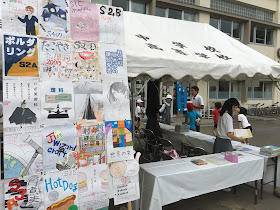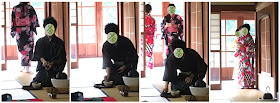 |
| Culture Festival (bunka-sai) reception with class posters |
Autumn is a busy time at Japanese schools with two major events to prepare: the culture festival (
bunka-sai =文化祭) and sports day (
undō-kai =運動会) - though in recent years, many schools have been moving the latter to spring due to lingering high temperatures and typhoons. This weekend I attended the former -
bunka-sai - at a local school which was full of the usual food stalls, performances, attractions, presentations, English debates, displays, and club activities one finds at such festivals. A new event this time round though was tea ceremony (
sadō = 茶道) which, like at many schools, is now an elective subject for third-year high-school students (judo has also become part of P.E. classes). The emphasis on learning "traditional culture" reflects the reform of the Fundamental Law of Education (Kyōiku Kihon Hō=教育基本法) in 2006 which for the first time introduced "fostering the value of respect for tradition and culture and love of the country" as an objective of education (English
here; Japanese
here).


At the culture festival, students made and served tea to guests while the teacher gave an explanation of the finer points of manners and etiquette. The students - both male and female - were traditionally dressed in
yukata (浴衣) - pictured left and right. The
yukata is a light cotton "kimono" a common sight at the many summer
firework displays. The first
kanji means to take a bath(
abiru =浴びる) which reflects the fact that it is also used as a bathrobe (hotels with hot springs will usually supply a simple
yukata for guests).
A common question relates to the difference between a
yukata and a kimono (着物) proper (here I focus on the female versions). Apart from the material (typically light cotton vs heavier silk), a key difference is that the hanging "wing" sleeves are longer in a
kimono, at least for single women (the
sode or sleeves of married women are shorter, similar to the
yukata). Another difference, is the time it takes to put on: whereas a
yukata can be put on in 10 minutes or so, a kimono is complex and without taking classes - or at least a little help - is pretty much impossible to put on by yourself. An inner layer or layers of underclothing is also worn with a
kimono. Finally, the belt or sash (
obi =帯) is tied differently: the yukata
obi is a simple bow which is tied at the front first (or sometimes comes pre-tied) and then slid around (video
here); in contrast, the kimono
obi is much broader and longer (and tighter!) and there are various ways of tying it (see one example
here). Below are some pictures of the students serving tea at the festival, though the snaps don't
do justice to the grace, refinement - and nervousness - of the
student participants!
 |
| A male student prepares the tea as female students carry more in for guests. Note the cast iron kettle (tetsubin) |


 At the culture festival, students made and served tea to guests while the teacher gave an explanation of the finer points of manners and etiquette. The students - both male and female - were traditionally dressed in yukata (浴衣) - pictured left and right. The yukata is a light cotton "kimono" a common sight at the many summer firework displays. The first kanji means to take a bath(abiru =浴びる) which reflects the fact that it is also used as a bathrobe (hotels with hot springs will usually supply a simple yukata for guests).
At the culture festival, students made and served tea to guests while the teacher gave an explanation of the finer points of manners and etiquette. The students - both male and female - were traditionally dressed in yukata (浴衣) - pictured left and right. The yukata is a light cotton "kimono" a common sight at the many summer firework displays. The first kanji means to take a bath(abiru =浴びる) which reflects the fact that it is also used as a bathrobe (hotels with hot springs will usually supply a simple yukata for guests).